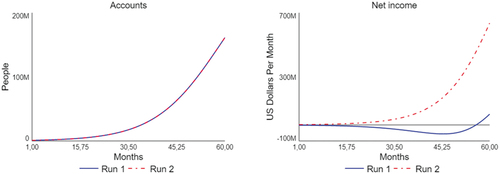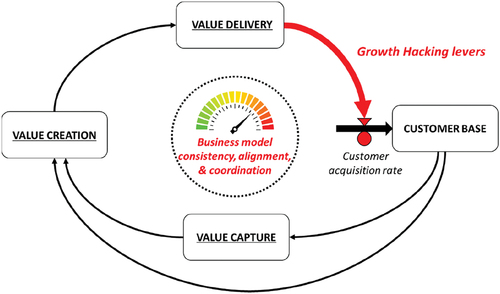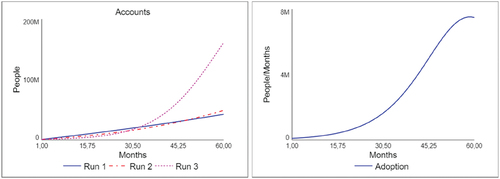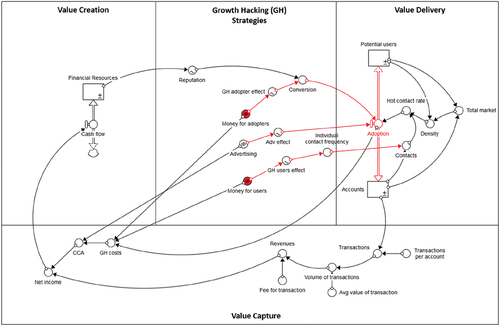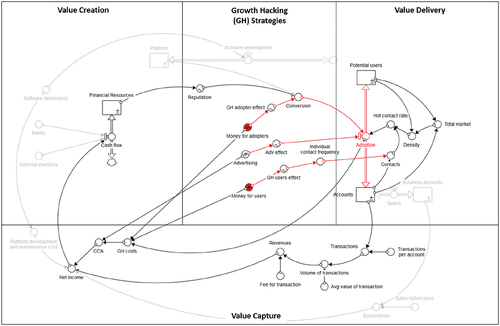ABSTRACT
Creating an innovative product and validating an innovative business model may not be enough for digital startups to be competitive. To grow fast and expand globally, digital startups need to innovate their business model during the scaling phase. A pragmatic approach has recently been proposed to support digital entrepreneurs engaging in business-model innovation during the scaling phase (i.e., business-model scaling), a strategy known as growth hacking. However, we know little about its theoretical grounding and how effective growth hacking is, as businesses lack methodologies to assess its effectiveness before committing resources and investments. To fill this gap, we developed a method for supporting business- model scaling through simulation modeling and provided an illustrative application to the PayPal case. By doing so, we contribute to the ongoing debate on scalability in digital entrepreneurship.
In the early stages of their development, new ventures are expected to create a “cool” product and design and validate a proven business model around it (Blank, Citation2013). Then what? “productive” entrepreneurs—those who are more ambitious, leading innovative, high-potential firms, will aim to make their businesses grow fast and expand globally (Henrekson & Stenkula, Citation2010; Stam, Citation2015). This is especially true in digital entrepreneurship, where startups operate in a dynamic and uncertain business environment. Digital entrepreneurship is fundamentally distinct from traditional entrepreneurship due to the impact of pervasive and multipurpose digital technologies increasing the pace of change, leading to significant transformations in the scope and scale of entrepreneurial outcomes (Cavallo et al., Citation2019; Nambisan, Citation2017). Within this context, creating an innovative product and designing and validating a business model is not enough. To make the business grow and expand, there is a need for new methods for experimenting and learning how to rapidly increase the customer base and thus revenues. This need was recently tackled through a pragmatic approach known in practice as growth hacking (Bohnsack & Liesner, Citation2019; Troisi et al., Citation2020). Growth hacking was first defined by Ellis (Citation2010) as “a process of rapid experimentation across the funnel to learn the most effective way to scale sustainable customer adoption.” In other words, this translates to focusing on innovation in the value delivery of the business model—intended as a mechanism to engage and convince customers to adopt a value proposition (Teece, Citation2010). A business model is defined as the “architecture of the value creation, delivery, and capture mechanisms [a firm] employs” (Teece, Citation2010, p. 191). According to Abdelkafi et al. (Citation2013), business- model innovation (BMI) happens “when the company modifies or improves at least one of the value dimensions” (p. 13). In a similar vein, Foss and Saebi (Citation2017) referred to BMI as “designed, novel, non-trivial changes to the key elements of a firm’s business model and/or the architecture linking these elements” (p. 201).
Research on BMI is abundant (Foss & Saebi, Citation2017) in the context of incumbents (e.g., Amit & Zott, Citation2012; Chesbrough, Citation2007) and startups (e.g., Ghezzi & Cavallo, Citation2020). However, research gaps remain (Schneckenberg et al., Citation2022). To date, research has failed to fully disentangle the BMI process with specific reference to the scaling phase and the role played by emerging approaches, such as growth hacking. Scaling involves: (a) growing revenues, (b) growing the customer base, and (c) adapting the firm to serve a large and usually global market (Sullivan, Citation2016). Contrasting arguments exist regarding what scale-up is, and the introduction of a static threshold has probably hindered research progress (Cavallo et al., Citation2019). For instance, according to Autio (Citation2016), scale-ups show significant traction with customers, have a validated business model, and have been funded through a first Series A round (over US$1 million). While we comprehend that this discussion may have garnered considerable attention by scholars and practitioners (and rightly so), we believe a much more relevant locus of investigation should be on “how”—rather than on “how much”—to make BMI for scaling and, more generally, to the scalability phase (Cavallo et al., Citation2019; Coviello, Citation2019; Shepherd & Patzelt, Citation2020). For the sake of this investigation, we introduce the construct of business-model scaling, intended as a peculiar business-model innovation and experimentation process specifically aimed at making the business grow fast and expand at global scale.
Enhancing our understanding of how to scale a business and the role of emerging approaches, such as growth hacking in this process, is relevant for multiple reasons. First, from a strategic standpoint, we already know that scale economies can be a relevant source of competitive advantage (Autio et al., Citation2018; Hennart, Citation2014). Second, from a practitioner’s perspective, the difficulty in being competitive for new ventures no longer lies in coming up with ideas (Verganti, Citation2022) or products but in getting the product known by the customers (Ellis, Citation2010). A good product that does not get enough attention from customers will not stand in a dynamic, competitive digital environment (Ellis & Brown, Citation2017). Third, practitioner approaches, such as growth hacking, are generally considered supportive for entrepreneurs in the scaling phase but often lack theoretical foundations. Moreover, we know little about how effective they are, as we lack methodologies to assess their effectiveness before committing resources and investments.
Given the above arguments, in this study, we aim to explore how firms may undertake business- model scaling by leveraging growth hacking. To do so, building on previous contributions (Cosenz, Citation2017; Cosenz & Bivona, Citation2021; Cosenz & Noto, Citation2018), we developed a method to support business- model scaling through simulation modeling called Dynamic Business Modeling (DBM) for Scaling, which can serve entrepreneurs when scaling through growth hacking. We applied this method to PayPal—when the company was a digital startup in its scaling phase—to show a practical example of its use.
By studying how firms may undertake business-model scaling and leverage a growth-hacking approach, we make at least two contributions to the literature. First, we show how simulation modeling can provide a protected and less costly strategic-learning environment for experimenting with business-model scaling to pursue effective growth-hacking strategies. While the use of computer simulations for experimentation is not new in the literature, as they have been used in new product development (see Thomke, Citation1998; Thomke et al., Citation1998) and BMI (see Cosenz & Noto, Citation2018), we propose a computer simulation method specifically tailored for business-model scaling. Second, we anchor growth hacking in the BMI field, thus, contributing to reducing the academic- practitioner divide concerning emerging experiment-based approaches in entrepreneurship (Dushnitsky & Matusik, Citation2019; Shepherd & Gruber, Citation2021). Despite being known in practice as an approach focused on value-delivery mechanisms and distribution channels (Ellis, Citation2010), we show how growth hacking often involves changes in other parts of the business model. From this perspective, the business model is seen as a dynamic and complex system (Massa & Tucci, Citation2013) made of interconnected and interdependent mechanisms of value creation, delivery, and capturing (Teece, Citation2010).
The structure of this study is as follows. The next section offers a review of the literature on BMI and the scaling phase, introducing growth hacking as an emerging approach to business-model scaling. Section 3 presents DBM for Scaling as a method for experimenting with growth-hacking strategies; Section 4 provides an illustrative application of this method to the PayPal case. Finally, we discuss implications for theory and practice in Section 5 and conclude with limitations and future research directions in Section 6.
Theoretical grounding
Business-model innovation and business-model scaling
The business model has largely referred to the value architecture of a business—that is, how the firm creates value, delivers such value to customers, and captures the related payoff (Baden Fuller & Morgan, Citation2010; Teece, Citation2010). Firms’ business models are dynamic in nature, and may evolve, change, and be sources or vehicles of innovation (Amit & Zott, Citation2001; Massa & Tucci, Citation2013; Mitchell & Coles, Citation2003). Several scholars and practitioners alike agree that beyond the isolated product, service, or process innovation, well-established companies and startups should now focus on innovating their business model (Chesbrough, Citation2007, Citation2010; Clauss, Citation2017; Colombo et al., Citation2016; Foss & Saebi, Citation2017; Lamperti et al., Citationin press; Massa et al., Citation2017). BMI captures the innovation of at least one of the foundational elements of a business (value creation, delivery, and capture), thus, providing a business with the evidence of new, often neglected, value sources within the organization or generating novel systems that are hard to replicate (Amit & Zott, Citation2012). Research on BMI evolved quickly in many directions, merging the constructs with other pragmatic and emerging ones, such as the circular economy (Bocken et al., Citation2019; Konietzko et al., Citation2020; Linder & Williander, Citation2017; Ritala et al., Citation2018), sustainability (Evans et al., Citation2017), and all sorts of digital trends (Burström et al., Citation2021; Lamperti et al., Citationin press). For instance, Soluk et al. (Citation2021) focused on digital BMI as a “new way of creating and capturing business value that is embodied in or enabled by digital technologies” (Fichman et al., Citation2014, p. 335). Lamperti et al. (Citationin press) connected business-model innovation and digital servitization to face and overcome disruption. Although the large body of literature continues to proliferate on different subtypes or subgroups of BMI, on a more theoretical level, research predominately focuses on either the antecedents of BMI, the outcomes, or what is in between—that is, the process (Foss & Saebi, Citation2017). The literature shows notable contributions of the BMI process, mainly regarding large organizations (e.g., Amit & Zott, Citation2012; Chesbrough, Citation2007; Ciulli & Kolk, Citation2019; Johnson et al., Citation2008; Schaltegger et al., Citation2012; Sosna et al., Citation2010), although BMI also applies to smaller organizations (Klewitz & Hansen, Citation2014; Lamperti et al., Citationin press). More recently, scholars have focused on new ventures undertaking BMI in their early stages of business-model design and validation (Felin et al., Citation2020; Ghezzi & Cavallo, Citation2020). However, startups with a validated (by customers) business model enter another critical step of their lifecycle in which they usually need to change and innovate the business model: the scaling phase (Cavallo et al., Citation2019). Scaling involves (a) growing revenue, (b) growing the customer base, and (c) adapting the firm to serve a large and usually global market (Sullivan, Citation2016). This is especially true in a digital and dynamic environment. Digital startups typically have two options: (a) to grow (fast) or (b) to die (Erdogan et al., Citation2016). Yet, research has been relatively silent concerning the peculiar BMI and experimentation process specifically aimed at making the business grow fast and expand on a global scale, which we define as the business-model scaling process. Filling this gap will advance our understanding of business-model scaling, which can yield important implications for entrepreneurs, their stakeholders, and their ventures.
An experiment-based approach for business-model scaling: Growth hacking
The business-model innovation process is fundamentally about experimentation (Baden Fuller & Morgan, Citation2010; Molina-Castillo et al., Citation2021). Business models are subject to constant experimentation, refinement, development, and renewal, reaching various degrees of novelty (Demil & Lecocq, Citation2010; Foss & Saebi, Citation2017; Sjödin et al., Citation2020). Entrepreneurs conduct business experiments to understand customer needs and test the value proposition and other key business- model elements from the early stages of startup development. They often leverage an experiment-based approach, such as the lean startup (Ghezzi & Cavallo, Citation2020; Harms & Schwery, Citation2020; Shepherd & Gruber, Citation2021). The lean startup, first proposed by practitioners (Ries, Citation2011), has also been recognized by scholars as a method that can guide entrepreneurs in developing a validated (by customers) business model (Bocken & Snihur, Citation2020; Yoo et al., Citation2018). However, we know that even startups with a validated business model may encounter difficulties in increasing their customer base for several reasons (e.g., a lack of money for massive marketing campaigns and/or intense competition). That is why BMI continues in the later stages of startup development and, more specifically, during the scaling phase. Inspired by principles similar to those of the lean startup (Bohnsack & Liesner, Citation2019), another practice-oriented approach that seems to guide entrepreneurs in dealing with the business-model scaling process has recently emerged: growth hacking.
Ellis (Citation2010) introduced this term when referring to a process of rapid experimentation and testing to scale the business (model). Growth hacking includes digitally enabled experiments and strategies to test a product and its ability to quickly gain new customers (Bohnsack & Liesner, Citation2019). One of the most well-known cases of growth hacking was Dropbox. Founded in 2007, the world-famous online file hosting and data storage service implemented an efficient referral loop system: sharing a file and inviting new users to use a Dropbox folder by sending a link via e-mail from one user to another. To encourage word of mouth, extra free storage space was offered if the e-mail recipient signed up for Dropbox. In a short period of time, through this strategy, Dropbox started to grow exponentially. Similar well-known cases include Airbnb, Hubspot, PayPal, and Hotmail. Companies that have been successful with growth-hacking strategies have usually developed a viral system that is naturally integrated into the onboarding phase. New customers typically learn about the product or service through their own network and, by using the product or service, share it with their connections. This cycle of awareness, use, and sharing of the product or service triggers exponential growth for the company.
One of the growth-hacking frameworks that is most used is the “pirate funnel,” developed by Dave McClure (founder of 500 startups). This funnel is a phased process that characterizes the flow of new users through five main stages: acquisition, activation, retention, revenue, and referral. These stages are necessary to lead visitors or users of a site, app, or product up to conversion (Herzberger & Jenny, Citation2018). In practice, the funnel and, more generally, growth hacking have become quite notorious; however, there is a lack of academic studies and of a solid theoretical foundation to support these practices. Stemming from a few seminal books (e.g., Ellis & Brown, Citation2017; Herzberger & Jenny, Citation2018), some scholars have linked growth hacking to the marketing research stream (Troisi et al., Citation2020), while others seem to suggest that this strategy plays a role beyond marketing (Bohnsack & Liesner, Citation2019). In line with this view, we deem that growth hacking may involve several value mechanisms of the business model while entering the scaling phase. However, this theoretical intuition needs to be empirically investigated.
Moreover, the process of experimentation through growth-hacking strategies can be challenging in practice. For instance, a common myth is that experimentation is always cheap. While it is true that the cost of experimentation is declining due to the use of digital technologies (Christensen, Citation2013), some scholars challenge the dominant view of “cheap” experimentation (Pillai et al., Citation2020). For instance, PayPal spent about US$60 million on its referral incentive system. Therefore, we believe that it can be relevant for practice to advance our knowledge of methods that can support experimentation through growth hacking before committing significant investments according to lean principles. However, despite the considerable attention that growth hacking has attracted from entrepreneurs and managers, the literature is quite silent in providing theoretical positioning and practical methods regarding this strategy. Therefore, advancing our understanding of growth hacking will provide important implications for research and practice.
A simulation-based method for business-model scaling
Business-model scaling using growth-hacking strategies: A methodological challenge
The background described above highlights a relevant methodological challenge for supporting business-model scaling using growth-hacking strategies. The emergent method should integrate the two interrelated scaling purposes to face this challenge in a viable way. These purposes are related to (a) expanding the customer base and associated revenues and (b) implementing more- structured and scalable organizational activities to strengthen alignment and consistency among the multiple business-model variables validated in the previous startup phase.
Refraining from integrating these purposes into a consistent methodological framework might lead the startup to an early failure due to an uncoordinated growth pattern unbalanced toward a myopic search for new customers (Davila et al., Citation2010; Harnish, Citation2014; Maurya, Citation2016). Therefore, business growth must be grounded in robust strategic coordination among the key business-model factors related not only to value delivery but also to value creation and capture. This entails the implementation of a scalable organizational architecture characterized by causal interplays underlying the complex coordination of how the business creates, delivers, and captures value. As Demir et al. (Citation2017) argued, the complexity of this coordination mechanism embraces the interplay of multiple high-growth drivers, such as human capital, human resource management, strategy, innovation, and capabilities.
Unlike the early startup phases, business-model scaling should focus on an experiment-based approach to test growth-hacking strategies and foster business-model consistency, thus supporting a viable growth pattern over time. This requires strategy design methods to explore and manage the inherent organizational complexity of the interacting business-model components. In addition, these methods must consider how a specific business model faces and copes with market competition in terms of growth-hacking levers (or strategies). These levers are specific strategies that may have major impacts on an increased customer base. For example, the introduction of professional pictures to post accommodation listings on Airbnb has been a strategic lever through which the company has grown its customer base exponentially. Although valuable for business- model design and validation, tools such as the business-model canvas fail to support scaling-related experiments, thereby, highlighting a new call for action to fill this relevant methodological gap. illustrates a systemic perspective on how to frame this call for action aimed at experimenting with growth-hacking strategies and fostering alignment for business-model consistency.
Dynamic business modeling for scaling
Taking on the above methodological challenge, this paper proposes the adoption of dynamic business modeling (DBM) for business-model scaling, leveraging growth-hacking strategies and alignment for business-model consistency. DBM draws on a combination of an adapted version of the business-model canvas and System Dynamics modeling (Bianchi, Citation2016; Cosenz & Noto, Citation2016; Forrester, Citation1958; Sterman, Citation2000). shows the rationale behind the adoption of DBM for Scaling. The use of System Dynamics enables the identification, exploration, and quantification of the business-model causal interplays, thus providing a more systemic perspective of the value creation, proposition, delivery, and capture mechanisms. In addition, moving from a qualitative perspective (i.e., the business-model canvas) to a quantitative perspective, DBM allows one to experiment with alternative scaling strategies through computer simulations.
Figure 2. The dynamic business-modeling for scaling method (adapted from Cosenz & Noto, Citation2018).

Different from previous applications (Cosenz, Citation2017; Cosenz & Bivona, Citation2021; Cosenz & Noto, Citation2018), DBM for Scaling focuses on two distinctive processes:
Measuring for scaling: Measuring the effect of growth-hacking strategies on the customer acquisition rate by identifying and investigating the scope of corresponding scaling drivers
Consistency while scaling: Evaluating the overall business-model consistency under the exponential growth of new customers caused by the implementation of growth-hacking strategies
The above processes take advantage of the methodological support provided by a simulation technique that is valuable for modeling and exploring organizational systems characterized by dynamism, complexity, and uncertainty (Davis et al., Citation2007). This support relies on the possibility of experimenting with simulation models to adopt more-consistent scaling strategies (Bouwman et al., Citation2021; Snihur et al., Citation2021). The need to balance the organizational aspects of the business model may benefit from analyzing how these models react to and support exceptional customer growth. For instance, an e-commerce startup may focus its financial efforts on pushing a particular creative marketing strategy that rapidly generates an exponential increase in its customer base. However, such an increase in product orders to process could clash with the original production capacity, whose saturation may cause a rise in the average product-delivery delay. Since the average delivery delay is a critical success factor in the e-commerce sector, a correlated decrease in customer satisfaction could be crucial to the startup’s survival in terms of customer loss. Thus, adequate consistency among the business-model components must be pursued to prevent similar undesired effects.
Using DBM for Scaling entails a more systemic view focused on the integration of feedback loops, resource accumulation and depletion processes, time delays, and nonlinear interplays to describe complex and dynamic feedback processes (Bianchi, Citation2016; Cosenz & Noto, Citation2016; Sterman, Citation2000). After identifying causal feedback loops, the main business-model components and their interplays are converted into stock-and-flow models using System Dynamics computer simulation software (Groesser & Jovy, Citation2016; Sterman, Citation2000). The computer simulation software we used was Stella Architect by Isee Systems. As shown in , these full-fledged simulation models are then framed into the four building blocks outlining value creation, delivery, capture, and growth-hacking strategies. As a result, these models enable entrepreneurs to simulate the behavior of the business system over time, thus offering a methodological groundwork for scaling-strategy experimentation. The input data of simulation models can be retrieved and collected in several ways, such as structured or semistructured interviews with business actors, company reports, financial statements, institutional websites, questionnaires, and business plans. These data are then used to quantify model variables (e.g., human or financial resources), as well as their causal interdependences (e.g., the effect of advertisement investment on the customer acquisition rate) through equations and graphical functions (Sterman, Citation2000).
Far from being conceived as a deterministic method, DBM for Scaling is used to provide entrepreneurs with interpretive lenses for exploring complex business systems and supporting their systematic strategic-learning processes through simulation-based experiments (McDonald & Eisenhardt, Citation2019). Therefore, we argue that such a method may be used to discover and test how to strengthen business-model scaling strategies. Experimenting with alternative scaling strategies in a controlled and protected learning environment allows businesses to prevent the actual implementation of dangerous action plans by replacing them with costless simulation scenarios. This is a possible methodological solution to realize effective and robust experimentation supporting business-model scaling and facilitating the pursuit of business-model consistency while leveraging on growth-hacking strategies.
The following section provides an illustrative application of the DBM for Scaling method to evaluate its effectiveness in experimenting with business-model scaling strategies and tracing the growth- hacking–driven pathway taken by PayPal.
An illustrative case: PayPal
PayPal is a well-known company operating in the fintech industry. Its business model is based on offering the possibility of performing worldwide financial transactions more simply and cheaply than banks and other financial companies do. PayPal was launched in 1999 as an online money transfer system. Customers could open their accounts online, deposit money, and link their account to credit cards.
Within the first 2 years, the company grew to 9 million accounts and over 120,000 transactions every day. In 2002, PayPal went public, and eBay soon acquired it. This high growth rate required a significant investment of financial resources to implement a referral incentive system. As such, the company was obliged to undertake a high financial risk to execute its growth-hacking strategy, which ex post turned out to be successful. This element makes the PayPal case study suitable for illustrating how our proposed method, DBM for Scaling, may support companies and their decision-makers in experimenting with growth-hacking strategies and understanding how these may interact with the existing business model by analyzing simulated behaviors.
PayPal’s value proposition is to create a safe and accepted worldwide payment system. Its key activities are mainly related to platform development and maintenance, supported by strong partnerships with the banking system. The platform core architecture, the related software applications, and channels to engage with new and existing users represent critical strategic resources (Cavallo et al., Citation2022).
Revenue streams are mainly related to the fees applied to transactions happening through the platform and the subscription price of business accounts, while the cost structure is primarily characterized by the cost of the platform’s maintenance and the customer acquisition cost (CAC).
Data collection and analysis
The model is aimed at exploring PayPal’s strategy during the first 5 years since its foundation. Consistent with System Dynamics principles (Sterman, Citation2000), the data and information collected to develop the PayPal model are both qualitative and quantitative and come from different sources explored in 2022. Qualitative information is used to outline and frame PayPal’s business model and the company’s strategies. This information was gathered through extensive desk research, including scientific articles (Amit & Zott, Citation2012; Bocken & Snihur, Citation2020; Comes & Berniker, Citation2008), business reports (PayPal, Citation2022), newspaper articles, and interviews (Khan Academy, Citation2014). In particular, this information enabled the creation of the PayPal DBM for Scaling feedback structure to develop what is called in the literature the “conceptualization phase” (Luna‐reyes & Andersen, Citation2003).
Quantitative data were collected from business and financial reports available on the U.S. Security and Exchange Commission (Citation2022) and company websites (PayPal, Citation2022). Moreover, since eBay acquired PayPal in 2002, other financial and operational information related to the first 5 years of activity was retrieved from eBay’s financial reports. Finally, external parameters and variables were quantified through desk research using multiple sources. In particular, potential users have been estimated considering the U.S. population (age 16–79) as the target population (U.S. Census Bureau, Citation2022) and regarding the advertising strategy, we considered a CAC equal to US$175 per user (Safko, Citation2012). This last set of information—that is, the quantitative data—was also used to validate the model structure and the overall model behavior, thus supporting the formulation and testing of the model reference behavior (Luna‐reyes & Andersen, Citation2003). displays the key variables and parameter quantification.
Table 1. Model variables and parameter values.
Findings
To apply DBM for Scaling to the case of PayPal, we adopted the previously described two-step process that characterizes business-model scaling. The first step focused on the effect of growth hacking on the user acquisition rate by identifying and exploring the scope of the corresponding scaling strategies. The second step started by framing the user acquisition dynamics. This enabled the implementation of the remaining part of the DBM for Scaling to analyze the effects related to the rapid growth of the user base on the other business-model elements. This second step is key to understanding whether the business can afford the expected users’ acquisition rate without experiencing unintended consequences, such as service disruption due to high demand (e.g., software crashes or poor customer service).
The structure and behavior of the DBM for Scaling model in running the simulations generating alternative scenarios have been validated (Barlas, Citation1996). In general, structure-validation tests assess the validity of the model structure by direct comparison with knowledge about the real system structure (Barlas, Citation1996). In this sense, the structure of the model was assessed by comparing its formulation with the knowledge and information available on the business and the revenue model of PayPal. Behavior validity is evaluated by comparing the model output with empirical data (Barlas, Citation1996; Homer, Citation2012). The reference behavior to check the model’s validity originates from the available data related to the business’s reference performance—that is, getting 9 million users within the first 2 years of activity. An extreme-conditions test (Barlas, Citation1996) was conducted by setting the stocks of potential users and accounts equal to 0. Other behavior-sensitivity tests (Barlas, Citation1996) were conducted on key parameters (average value of transaction, fee for transaction, and transaction per account) to assess whether the simulated performance in terms of user acquisition and net income increases/decreases consistently.
Next, we present the two steps of the DBM for Scaling method.
Step 1. Measuring for scaling
The case of PayPal has attracted much attention from scholars and practitioners because of the rapid growth of its user base, which (at some point) reached a 10% daily rate. The main growth- hacking strategy employed to achieve such a remarkable growth rate was based on a referral mechanism. The company offered a monetary reward to each new user and those referring other users. As reported in an interview with Elon Musk (Khan Academy, Citation2014):
Well, we started off first by offering people $20 if they opened an account. And $20 if they referred anyone. And then we dropped it to $10. And we dropped it to $5. As the network got bigger and bigger, the value of the network itself exceeded any sort of carrot that we could offer.
This growth-hacking strategy can be considered an alternative to traditional advertising campaigns. DBM for Scaling allows entrepreneurs to experiment with multiple strategies to understand their potential impact on business performance. As such, DBM for Scaling was refined to test alternative customer acquisition strategies based on referrals (i.e., those that can be considered growth- hacking strategies) and traditional mechanisms.
. illustrates the causal relationships between the key processes (i.e., the potential users’ acquisition levers) and the inflow of new users adopting PayPal payment solutions.
As shown in , the model includes three variables (filled in dark gray). The quantification of these variables can be changed, thus, enabling simulation experiments and related scenario analyses. In particular, two (i.e., “money for users” and “money for adopters”) are related to growth- hacking strategies and may range from US$0 to US$20. “Money for users” represents the amount of money the company may give to existing users for each successful referral. “Money for adopters” refers to the amount of cash PayPal may provide to new users creating accounts. This variable may range from US$0 to US$20.
The third variable (i.e., “advertising”) represents the company’s budget for traditional marketing campaigns. It is computed to range from US$0 to US$100 million.
By changing the above parameters, decision-makers may test ex ante alternative scenarios of customers’ acquisition tactics. In particular, three model runs have been tested in a 5-year time frame.
The results of Run 1 show the behavior in terms of accounts in the case of an investment of US$100 million in traditional marketing campaigns. In this scenario, the company would manage to gain about 40 million users within 5 years.
Run 2 depicts an intermediate situation in which the company invests US$50 million in traditional marketing campaigns and offers US$10 to each new adopter and each successful user referral.
Finally, Run 3 depicts the potential behavior in implementing growth-hacking strategies—that is, offering US$20 to new adopters and existing users for each referral. In this case, the acquisition of new customers shows an exponential growth behavior that would allow for more than doubling the number of users gained in the other scenarios.
compares the results of the three alternative scenarios in a 5-year time horizon (60 months). The graphs show the comparative number of accounts created (left) and the flow of new users adopting the payment method in Run 3 (right).
Step 2. Consistency while scaling
The second step in analyzing scaling is the evaluation of overall business-model consistency. Namely, this step aims to answer the following critical issue: Can the business-model support the expected growth of the customer base?
In addition, this evaluation supports decision-makers in understanding how value is captured from new customers and how the value captured feeds back into the value creation and delivery mechanisms.
From the analysis of the PayPal case, a complete version of the DBM was developed ().
shows how new user accounts generate revenues and the cost structure related to growth hacking and advertising strategies. The net income comes from the difference between revenues and the CAC. This is directly connected to the company’s financial performance, which in turn affects the company’s reputation.
reports the simulation results of the above-described scenarios regarding value capture and creation. In particular, the graphs display the comparison between the CAC and revenues in Run 3 (right) and the comparative net income (left).
Figure 6. Experimenting with business-model consistency with alternative scenarios through PayPal’s DBM for scaling.
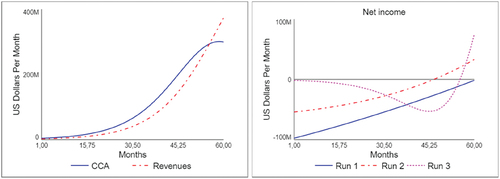
Based on the simulation results shown in , we can conclude that the company would have a successful performance within 5 years in each simulation run.
In the first scenario (Run 1), the company would achieve a positive net income after 5 years. In the second scenario (Run 2), we notice better performance in terms of new accounts than in Run 1 and a net income equal to 0 within about 4 years. Finally, in Run 3, although until month 45, the net income shows a decreasing trend—implying a strong effort in terms of financial resources—the rapid acquisition of new customers makes the net income surpass the one resulting from the two previous scenarios within 60 months.
Other solutions can also be tested through the model. Moreover, the second step of the analysis can be extended to include other key variables of the business model, such as partnerships with banks and processes related to software development (in , we show, in light gray, examples of other variables that could be taken into account). The simulations and graphical representations are provided here to show the potential support that DBM for Scaling can offer in creating a safe environment to experiment with growth-hacking strategies before their implementation.
According to the two-step process, DBM enables exploration and experimentation with alternative user acquisition strategies and an understanding of whether these strategies are viable from a business-model consistency perspective.
Discussion
In this paper, we set out to investigate how digital startups can scale their business model and the role of emerging approaches, such as growth hacking, in this process. Digital startups often undergo business-model innovation to grow and scale their businesses rapidly—that is, business- model scaling (Cavallo et al., Citation2019). Growth hacking is gaining much attention among practitioners as a useful, pragmatic approach to guiding business-model scaling. However, while implementing growth-hacking strategies, digital entrepreneurs face the challenge of committing large investments. Indeed, while digital startups progress from validating their business model to growing their company fast, experimentation becomes less “cheap” (Pillai et al., Citation2020) and calls for new approaches supporting growth hacking. Building on previous studies (Cosenz, Citation2017), we proposed a computer simulation method (i.e., DBM for Scaling) that is specifically tailored for business-model scaling in digital entrepreneurship and supports and complements growth hacking. In particular, we identify and conceptualize two key processes of business-model scaling in which DBM for Scaling can provide methodological support: measuring for scaling and consistency while scaling. The first process illustrates how to measure the effect of growth-hacking strategies on the customer acquisition rate by identifying and investigating the scope of the corresponding scaling drivers. The second process, consistency while scaling, shows how to practically evaluate the overall business-model consistency under the exponential growth of the customer base caused by the implementation of growth-hacking strategies. Moreover, we provide a first attempt to build a theoretical foundation and positioning of growth hacking in business-model research. Below, we elaborate on these insights and discuss theoretical and managerial implications, while paving the way for future research directions.
Implications for theory
This study contributes to theory in several ways. First, we propose the DBM for Scaling method, a computer simulation model specifically tailored for business-model scaling in digital entrepreneurship. Previous contributions had the merit of introducing DBM in the business-model innovation stream, but their focus was on business-model design (Cosenz, Citation2017; Cosenz & Noto, Citation2018) and validation in the SME context (Cosenz & Bivona, Citation2021). Täuscher and Abdelkafi (Citation2018), provide a valuable contribution by employing computer simulations to assess how business-model design elements and processes may create favorable conditions for scalability according to a sustainable perspective. Conversely, our proposed method enters into play when there is already a well-defined and working business model in digital startups that needs to be strategically reinforced to expand the customer base and scale. Indeed, this condition places a huge premium on simulation experiments. This provides a first answer to recent research calls on how to pursue the scaling-up of organizations (Shepherd & Patzelt, Citation2020). Our study is not only employing a computer simulation method as an empirical research method but also developing a methodological approach that frames the use of System Dynamics simulation models into an adapted version of the business-model canvas (i.e., the DBM for Scaling). This will simplify the understanding of the business-model mechanisms by a larger number of business stakeholders, who are usually not System Dynamics experts. Moreover, we originally propose two key processes of business-model scaling in which DBM for Scaling can provide methodological support: measuring for scaling and consistency while scaling. We argue that monitoring and controlling such processes is fundamental for each digital startup looking for growth. We encourage future research to further investigate from different angles and approaches, whether these or other processes may characterize and foster business-model scaling in digital startups and beyond.
Second, we contribute to the current discussions on business experimentation in entrepreneurship (Bocken & Snihur, Citation2020). While the use of computer simulations in new product development is not new in the literature (see Thomke, Citation1998; Thomke et al., Citation1998), our new computer simulation method (DBM for Scaling) supports and complements an emerging approach for running business-model experiments in the scaling phase: growth hacking. Growth hacking is known among entrepreneurs as an approach to increasing the customer base and growing fast. Often, this approach is erroneously considered “cheap” in practice. While it may happen that growth hacking can be implemented at a cheap price in a specific context, that is not a rule. For instance, in the illustrative case of PayPal, an expensive, although effective, growth-hacking strategy was implemented. According to Elon Musk, PayPal spent about US$60 million on referral incentives. Therefore, DBM for Scaling may serve as a method for discovering and testing how to strengthen business-model scalability while using growth-hacking strategies. Experimenting with alternative growth-hacking strategies in a controlled and protected learning environment allows businesses to prevent the actual implementation of dangerous action plans by running costless simulation scenarios first.
Third, our study shows how growth-hacking strategies may go beyond marketing activities and involve the overall business-model value architecture and related value mechanisms. Therefore, we position growth hacking in the broader debate on the business-model scaling process. This extends early studies that introduced growth hacking as a mere new marketing strategy that is opposed to traditional marketing (Troisi et al., Citation2020). We believe that the role of growth hacking may go beyond that and involve the BMI process in one of the most critical startup development phases: the scaling phase. Moreover, theorizing on common practices largely adopted by practitioners, such as growth hacking (Delery & Doty, Citation1996; Shepherd & Gruber, Citation2021), by providing a much clearer positioning through discussing antecedents and connecting these practices to established research streams (such as the business model and BMI literature) is crucial when attempting to build theoretical foundations (e.g., Baker, Citation2007) and reduce the academic-practitioner divide (Shepherd & Gruber, Citation2021). This study is a first step toward building a theoretical foundation for growth hacking and its role in business-model scaling, which opens up a promising research avenue for further academic contributions.
Finally, our study adds to the debate on BMI with specific reference to the scaling phase of startup development. To date, BMI studies have mainly focused on incumbents looking for renewal (Demil & Lecocq, Citation2010) or startups in the early stages of business-model design and validation (Ghezzi & Cavallo, Citation2020), leaving much room for further investigation in the later scaling phase of startup development (Cavallo et al., Citation2019; Shepherd & Patzelt, Citation2020). Our study represents a first contribution in this direction. We originally positioned and described the business-model scaling construct as a peculiar business-model innovation and experimentation process specifically aimed at making the business grow fast and expand at a global scale. Providing clarity of specific constructs, such as business-model scaling, is important to stimulate and guide future research.
Implications for practice
This study has important practical implications. The proposed DBM for Scaling method supports and smoothens the business scaling of digital startups that leverage emerging growth-hacking strategies. Entrepreneurs may use DBM and computer simulations to experiment and learn before committing high investments to growth-hacking strategies. This applies even more to startups that face high competition, making any growth attempt to quickly acquire more customers, more expensive. We are not suggesting that all growth-hacking strategies are expensive, rather we suggest that our DBM for Scaling can help, especially when it does get expensive to grow. Other stakeholders may also find the DBM for Scaling method for business scaling useful. For instance, incubators, venture capitalists, and angels that usually provide managerial support and knowledge to new ventures should be aware of a method that can support experimentation and scaling. On a broader level, policy makers may support the knowledge diffusion and transfer of System Dynamics and system-thinking methods to prepare new generations of entrepreneurs while dealing with the dynamic complexity of the BMI process.
Conclusion
This study started from the fundamental assumption that digital entrepreneurs—after validating their business model—face the challenge of the scaling phase, in which “cheap” experiments may not be enough to grow rapidly and expand. We introduce growth hacking as an emerging approach to business-model scaling. Although growth hacking is gaining a lot of attention among practitioners, it is still mostly ignored in entrepreneurship-and-strategy research. In particular, we know little about its theoretical foundation, and we lack methodologies to assess growth-hacking strategies before committing large investments. Rooted in this context, this study has explored how digital startups may approach the scaling phase and the role of growth hacking in this process. The contributions of this study are built on two main pillars: a computer simulation method specifically tailored for business-model scaling in digital entrepreneurship supporting and complementing growth hacking and a first attempt to build theoretical foundations and positioning of growth hacking in business-model research.
The present study is not free of limitations. For instance, we provide an illustrative application case to show the practical use of DMB for Scaling. Although this is consistent with the research aim of the present study, future research will benefit from other applications to further improve and evolve our proposed method. In addition, our study is limited in context. We focus on digital startups in the scaling phase, but we believe that several large corporations are yet witnessing the same need while launching new products, business lines, and even new (corporate) ventures. Therefore, we encourage research to further explore business-model scaling and growth hacking in incumbent firms, which are especially in need of methods and approaches to innovate their businesses. This will advance the ongoing (although still emerging) debate on digital corporate entrepreneurship.
Moreover, although our paper provides an illustrative application based on PayPal’s referral program as a growth-hacking strategy, this is not the only growth-hacking strategy digital startups can leverage on. The referral program can be very expensive and inaccessible to apply for many digital startups. The case of PayPal served the purpose of the present study, given the early stage of development of research on growth hacking and business-model scaling and considering that it is largely diffused among digital startups. However, we encourage future studies to explore other empirical settings and alternative methods to advance our current understanding of scalability in digital entrepreneurship.
Overall, we conclude that advancing the current understanding of business-model innovation in the scaling phase is a relevant and urgent topic. Pervasive and multipurpose digital technologies are influencing, reshaping, or even destroying entire industries (Nambisan, Citation2017), and new digital ventures are often leading this change in the business environment by proposing and validating innovative products and services. However, having a valid value proposition will not be enough. The “competitive war” between digital startups is no longer on products but on getting the product known by customers. A good product that does not get enough attention from customers will not stand in a dynamic, competitive digital environment (Ellis & Brown, Citation2017). Research needs to focus on and advance our knowledge of how to enhance business-model scaling and related supportive methods in digital entrepreneurship.
Acknowledgments
We are thankful to the editor and the anonymous reviewers who helped us significantly improve the clarity of our study’s contributions through the revision process. Any remaining errors are our own.
Disclosure statement
No potential conflict of interest was reported by the authors.
References
- Abdelkafi, N., Makhotin, S., & Posselt, T. (2013). Business model innovations for electric mobility—what can be learned from existing business model patterns? International Journal of Innovation Management, 17(1), 1340003. https://doi.org/10.1142/S1363919613400033
- Amit, R., & Zott, C. (2001). Value creation in e‐business. Strategic Management Journal, 22(6–7), 493–520. https://doi.org/10.1002/smj.187
- Amit, R., & Zott, C. (2012). Creating value through business model innovation. MIT Sloan Management Review, 53(3), 41–49.
- Autio, E. (2016). Entrepreneurship support in Europe: Trends and challenges for EU policy. Imperial College Business School.
- Autio, E., Nambisan, S., Thomas, L. D. W., & Wright, M. (2018). Digital affordances, spatial affordances, and the genesis of entrepreneurial ecosystems. Strategic Entrepreneurship Journal, 12(1), 72–95. https://doi.org/10.1002/sej.1266
- Baden Fuller, C., & Morgan, M. S. (2010). Business models as models. Long Range Planning, 43(2–3), 156–171. https://doi.org/10.1016/j.lrp.2010.02.005
- Baker, S. D. (2007). Followership: The theoretical foundation of a contemporary construct. Journal of Leadership & Organizational Studies, 14(1), 50–60. https://doi.org/10.1177/0002831207304343
- Barlas, Y. (1996). Formal aspects of model validity and validation in system dynamics. System Dynamics Review, 12(3), 183–210. doi:10.1002/(SICI)1099-1727(199623)12:3<183:AID-SDR103>3.0.CO;2-4
- Bianchi, C. (2016). Dynamic performance management. Springer.
- Blank, S. (2013). Why the lean startup changes everything. Harvard Business Review, 91(5), 63–72.
- Bocken, N., Boons, F., & Baldassarre, B. (2019). Sustainable business model experimentation by understanding ecologies of business models. Journal of Cleaner Production, 208, 1498–1512. https://doi.org/10.1016/j.jclepro.2018.10.159
- Bocken, N., & Snihur, Y. (2020). Lean startup and the business model: Experimenting for novelty and impact. Long Range Planning, 53(4), 101953. https://doi.org/10.1016/j.lrp.2019.101953
- Bohnsack, R., & Liesner, M. M. (2019). What the hack? A growth hacking taxonomy and practical applications for firms. Business Horizons, 62(6), 799–818. https://doi.org/10.1016/j.bushor.2019.09.001
- Bouwman, H., de Reuver, M., Heikkilä, M., & Fielt, E. (2021). Business model tooling: Where research and practice meet. Electronic Markets, 30(3), 413–419. https://doi.org/10.1007/s12525-020-00424-5
- Burström, T., Parida, V., Lahti, T., & Wincent, J. (2021). AI-enabled business-model innovation and transformation in industrial ecosystems: A framework, model and outline for further research. Journal of Business Research, 127, 85–95. https://doi.org/10.1016/j.jbusres.2021.01.016
- Cavallo, A., Burgers, H., Ghezzi, A., & Van de Vrande, V. (2022). The evolving nature of open innovation governance: A study of a digital platform development in collaboration with a big science centre. Technovation, 116, 102370. https://doi.org/10.1016/j.technovation.2021.102370
- Cavallo, A., Ghezzi, A., Dell’era, C., & Pellizzoni, E. (2019). Fostering digital entrepreneurship from startup to scale-up: The role of venture capital funds and angel groups. Technological Forecasting and Social Change, 145, 24–35. https://doi.org/10.1016/j.techfore.2019.04.022
- Chesbrough, H. (2007). Business model innovation: It’s not just about technology anymore. Strategy & Leadership, 35(6), 12–17. https://doi.org/10.1108/10878570710833714
- Chesbrough, H. (2010). Business model innovation: Opportunities and barriers. Long Range Planning, 43(2), 354–363. https://doi.org/10.1016/j.lrp.2009.07.010
- Christensen, C. M. (2013). The innovator’s dilemma: When new technologies cause great firms to fail. Harvard Business Review Press.
- Ciulli, F., & Kolk, A. (2019). Incumbents and business model innovation for the sharing economy: Implications for sustainability. Journal of Cleaner Production, 214, 995–1010. https://doi.org/10.1016/j.jclepro.2018.12.295
- Clauss, T. (2017). Measuring business model innovation: Conceptualization, scale development, and proof of performance. R&D Management, 47(3), 385–403. https://doi.org/10.1111/radm.12186
- Colombo, M. G., Cumming, D., Mohammadi, A., Rossi Lamastra, C., & Wadhwa, A. (2016). Open business models and venture capital finance. Industrial and Corporate Change, 25(2), 353–370. https://doi.org/10.1093/icc/dtw001
- Comes, S., & Berniker, L. (2008). Business Model Innovation. In D. Pantaleo & N. Pal (Eds.), From Strategy to Execution (pp. 65–86). Springer.
- Cosenz, F. (2017). Supporting start-up business model design through system dynamics modelling. Management Decision, 55(1), 57–80. https://doi.org/10.1108/MD-06-2016-0395
- Cosenz, F., & Bivona, E. (2021). Fostering growth patterns of SMEs through business model innovation. A tailored dynamic business modelling approach. Journal of Business Research, 130, 658–669. https://doi.org/10.1016/j.jbusres.2020.03.003
- Cosenz, F., & Noto, G. (2016). Applying system dynamics modelling to strategic management: A literature review. Systems Research & Behavioral Science, 33(6), 703–741. https://doi.org/10.1002/sres.2386
- Cosenz, F., & Noto, G. (2018). A dynamic business modelling approach to design and experiment new business venture strategies. Long Range Planning, 51(1), 127–140. https://doi.org/10.1016/j.lrp.2017.07.001
- Coviello, N. E., 2019. Is a high-growth firm the same as a ‘scale-up’? 2019 Lazaridis Report. Lazaridis Institute for the Management of Technology Enterprises,
- Davila, A., Foster, G., & Jia, N. (2010). Building sustainable high growth startup companies: Management systems as an accelerator. California Management Review, 52(3), 79–105. https://doi.org/10.1525/cmr.2010.52.3.79
- Davis, J. P., Eisenhardt, K. M., & Bingham, C. B. (2007). Developing theory through simulation methods. Academy of Management Review, 32(2), 480–499. https://doi.org/10.5465/amr.2007.24351453
- Delery, J. E., & Doty, D. H. (1996). Modes of theorizing in strategic human resource management: Tests of universalistic, contingency, and configurational performance predictions. Academy of Management Journal, 39(4), 802–835. https://doi.org/10.2307/256713
- Demil, B., & Lecocq, X. (2010). Business model evolution: In search of dynamic consistency. Long Range Planning, 43(2/3), 227–246. https://doi.org/10.1016/j.lrp.2010.02.004
- Demir, R., Wennberg, K., & McKelvie, A. (2017). The strategic management of high-growth firms: A review and theoretical conceptualization. Long Range Planning, 50(4), 431–456. https://doi.org/10.1016/j.lrp.2016.09.004
- Dushnitsky, G., & Matusik, S. F. (2019). A fresh look at patterns and assumptions in the field of entrepreneurship: What can we learn? Strategic Entrepreneurship Journal, 13(4), 437–447. https://doi.org/10.1002/sej.1324
- Ellis, S. (2010). Find a growth hacker for your startup. Startup Marketing. http://www.startup-marketing.com/where-are-all-the-growth-hackers/
- Ellis, S., & Brown, M. (2017). Hacking growth: How today’s fastest-growing companies drive breakout success (1st ed.). Virgin Books.
- Erdogan, B., Kant, R., Miller, A., & Sprague, K. (2016). Grow fast or die slow: Why unicorns are staying private. McKinsey.com.
- Evans, S., Vladimirova, D., Holgado, M., Van Fossen, K., Yang, M., Silva, E. A., & Barlow, C. Y. (2017). Business model innovation for sustainability: Towards a unified perspective for creation of sustainable business models. Business Strategy and the Environment, 26(5), 597–608. https://doi.org/10.1002/bse.1939
- Felin, T., Gambardella, A., Stern, S., & Zenger, T. (2020). Lean startup and the business model: Experimentation revisited. Long Range Planning, 53(4), 101953. https://doi.org/10.1016/j.lrp.2019.06.002
- Fichman, R. G., Dos Santos, B. L., & Zheng, Z. (2014). Digital innovation as a fundamental and powerful concept in the information systems curriculum. MIS Quarterly, 38(2), 329-A15. https://doi.org/10.25300/MISQ/2014/38.2.01
- Forrester, J. W. (1958). Industrial dynamics-A major breakthrough for decision-makers. Harvard Business Review, 36(4), 37–66.
- Foss, N. J., & Saebi, T. (2017). Fifteen years of research on business model innovation: How far have we come, and where should we go? Journal of Management, 43(1), 200–227. https://doi.org/10.1177/0149206316675927
- Ghezzi, A., & Cavallo, A. (2020). Agile business model innovation in digital entrepreneurship: Lean startup approaches. Journal of Business Research, 110, 519–537. https://doi.org/10.1016/j.jbusres.2018.06.013
- Groesser, S. N., & Jovy, N. (2016). Business model analysis using computational modeling: A strategy tool for exploration and decision-making. Journal of Management Control, 27(1), 61–88. https://doi.org/10.1007/s00187-015-0222-1
- Harms, R., & Schwery, M. (2020). Lean startup: Operationalizing lean startup capability and testing its performance implications. Journal of Small Business Management, 58(1), 200–223. https://doi.org/10.1080/00472778.2019.1659677
- Harnish, V. (2014). Scaling up: How a Few companies make it…and why the rest don’t. Gazelles Publishing.
- Hennart, J. F. (2014). The accidental internationalists: A theory of born globals. Entrepreneurship Theory & Practice, 38(1), 117–135. https://doi.org/10.1111/etap.12076
- Henrekson, M., & Stenkula, M. (2010). Entrepreneurship and public policy. In Z. J. Acs & D. B. Audretsch (Eds.), Handbook of Entrepreneurship Research (pp. 595–637). Springer.
- Herzberger, T., & Jenny, S. (2018). Growth hacking: Mehrwachstum, mehr kunden, mehr erfolg (1st ed.). Rheinwerk Verlag.
- Homer, J. B. (2012). Partial‐model testing as a validation tool for system dynamics (1983). System Dynamics Review, 28(3), 281–294. https://doi.org/10.1002/sdr.1478
- Johnson, M. W., Christensen, C. M., & Kagermann, H. (2008). Reinventing your business model. Harvard Business Review, 86(12), 57–68.
- Khan Academy. (2014). Elon Musk - CEO of Tesla Motors and SpaceX. https://www.khanacademy.org/college-careers-more/entrepreneurship2/interviews-entrepreneurs/copy-of-khan-academy-living-room-chats/v/elon-musk
- Klewitz, J., & Hansen, E. G. (2014). Sustainability-oriented innovation of SMEs: A systematic review. Journal of Cleaner Production, 65, 57–75. https://doi.org/10.1016/j.jclepro.2013.07.017
- Konietzko, J., Baldassarre, B., Brown, P., Bocken, N., & Hultink, E. J. (2020). Circular business model experimentation: Demystifying assumptions. Journal of Cleaner Production, 277, 122596. https://doi.org/10.1016/j.jclepro.2020.122596
- Lamperti, S., Cavallo, A., & Sassanelli, C. (in press). Digital servitization and business model innovation in SMEs: A model to escape from market disruption. IEEE Transactions on Engineering Management. https://doi.org/10.1109/TEM.2022.3233132
- Linder, M., & Williander, M. (2017). Circular business model innovation: Inherent uncertainties. Business Strategy and the Environment, 26(2), 182–196. https://doi.org/10.1002/bse.1906
- Luna‐reyes, L. F., & Andersen, D. L. (2003). Collecting and analyzing qualitative data for system dynamics: Methods and models. System Dynamics Review, 19(4), 271–296. https://doi.org/10.1002/sdr.280
- Massa, L., & Tucci, C. L. (2013). Business model innovation. The Oxford Handbook of Innovation Management, 20(18), 420–441.
- Massa, L., Tucci, C. L., & Afuah, A. (2017). A critical assessment of business model research. The Academy of Management Annals, 11(1), 73–104. https://doi.org/10.5465/annals.2014.0072
- Maurya, A. (2016). Scaling lean: Mastering the key metrics for startup growth. Penguin.
- McDonald, R., & Eisenhardt, K. (2019). Parallel play: Startups, nascent markets, and the search for a viable business model. Administrative Science Quarterly, 65(2), 483–523. https://doi.org/10.1177/0001839219852349
- Mitchell, D., & Coles, C. (2003). The ultimate competitive advantage of continuing business model innovation. The Journal of Business Strategy, 24(5), 15–21. https://doi.org/10.1108/02756660310504924
- Molina-Castillo, F. J., de Reuver, M., Bouwman, H., & Clavel, J. G. (2021). Business model experimentation in SMEs: The application of a dual scaling technique. Economics of Innovation and New Technology, 1–23. https://doi.org/10.1080/10438599.2021.1974299
- Nambisan, S. (2017). Digital entrepreneurship: Toward a digital technology perspective of entrepreneurship. Entrepreneurship Theory and Practice, 41(6), 1029–1055.
- PayPal. (2022). Investor update 2022. https://investor.pypl.com/home/default.aspx
- Pillai, S. D., Goldfarb, B., & Kirsch, D. A. (2020). The origins of firm strategy: Learning by economic experimentation and strategic pivots in the early automobile industry. Strategic Management Journal, 41(3), 369–399. https://doi.org/10.1002/smj.3102
- Ries, E. (2011). The lean startup. Crown Books.
- Ritala, P., Huotari, P., Bocken, N., Albareda, L., & Puumalainen, K. (2018). Sustainable business model adoption among S&P 500 firms: A longitudinal content analysis study. Journal of Cleaner Production, 170, 216–226. https://doi.org/10.1016/j.jclepro.2017.09.159
- Safko, L. (2012). Fusion marketing bible. McGraw-Hill Publishing.
- Schaltegger, S., Lüdeke-Freund, F., & Hansen, E. G. (2012). Business cases for sustainability: The role of business model innovation for corporate sustainability. International Journal of Innovation and Sustainable Development, 6(2), 95–119. https://doi.org/10.1504/IJISD.2012.046944
- Schneckenberg, D., Matzler, K., & Spieth, P. (2022). Theorizing business model innovation: An organizing framework of research dimensions and future perspectives. R&D Management, 52(3), 593–609. https://doi.org/10.1111/radm.12506
- Shepherd, D. A., & Gruber, M. (2021). The lean startup framework: Closing the academic–practitioner divide. Entrepreneurship Theory & Practice, 45(5), 967–998. https://doi.org/10.1177/1042258719899415
- Shepherd, D. A., & Patzelt, H. (2020). A call for research on the scaling of organizations and the scaling of social impact. Entrepreneurship Theory & Practice, 46(2), 255–268. https://doi.org/10.1177/1042258720950599
- Sjödin, D., Parida, V., Jovanovic, M., & Visnjic, I. (2020). Value creation and value capture alignment in business model innovation: A process view on outcome‐based business models. Journal of Product Innovation Management, 37(2), 158–183. https://doi.org/10.1111/jpim.12516
- Snihur, Y., Lamine, W., & Wright, M. (2021). Educating engineers to develop new business models: Exploiting entrepreneurial opportunities in technology-based firms. Technological Forecasting and Social Change, 164, 119518. https://doi.org/10.1016/j.techfore.2018.11.011
- Soluk, J., Miroshnychenko, I., Kammerlander, N., & De Massis, A. (2021). Family influence and digital business model innovation: The enabling role of dynamic capabilities. Entrepreneurship Theory & Practice, 45(4), 867–905. https://doi.org/10.1177/1042258721998946
- Sosna, M., Trevinyo-Rodríguez, R. N., & Velamuri, S. R. (2010). Business model innovation through trial-and-error learning: The naturhouse case. Long Range Planning, 43(2–3), 383–407. https://doi.org/10.1016/j.lrp.2010.02.003
- Stam, E. (2015). Entrepreneurial ecosystems and regional policy: A sympathetic critique. European Planning Studies, 23(9), 1759–1769. https://doi.org/10.1080/09654313.2015.1061484
- Sterman, J. (2000). Business dynamics: System thinking and modelling for a complex world. McGraw-Hill.
- Sullivan, T. (2016). Blitzscaling: The chaotic, sometimes grueling path to high-growth, high-impact entrepreneurship. Harvard Business Review, 94(4), 44–50. https://doi.org/10.1016/j.lrp.2021.102101
- Täuscher, K., & Abdelkafi, N. (2018). Scalability and robustness of business models for sustainability: A simulation experiment. Journal of Cleaner Production, 170, 654–664. https://doi.org/10.1016/j.jclepro.2017.09.023
- Teece, D. J. (2010). Business models, business strategy and innovation. Long Range Planning, 43(2–3), 172–194. https://doi.org/10.1016/j.lrp.2009.07.003
- Thomke, S. H. (1998). Managing experimentation in the design of new products. Management Science, 44(6), 743–762. https://doi.org/10.1287/mnsc.44.6.743
- Thomke, S., Von Hippel, E., & Franke, R. (1998). Modes of experimentation: An innovation process—and competitive—variable. Research Policy, 27(3), 315–332. https://doi.org/10.1016/S0048-7333(98)00041-9
- Troisi, O., Maione, G., Grimaldi, M., & Loia, F. (2020). Growth hacking: Insights on data-driven decision-making from three firms. Industrial Marketing Management, 90, 538–557. https://doi.org/10.1016/j.indmarman.2019.08.005
- U.S. Census Bureau. (2022). Census data. https://data.census.gov/U.S
- U. S. Security & Exchange Commission. (2022). Company search results: PayPal Inc. https://www.sec.gov/edgar/browse/?CIK=1103415
- Verganti, R. (2018). Overcrowded: Designing meaningful products in a world awash with ideas. The MIT Press.
- Yoo, O. S., Huang, T., & Arifoğlu, K. (2021). A theoretical analysis of the lean startup method. Marketing Science, 40(3), 395–412. https://doi.org/10.1287/mksc.2020.1269
Appendix. Validation tests
Extreme scenario analysis
1) Potential user = 0 people; Run 1: Reference behavior (GH strategy in place); Run 2: Test
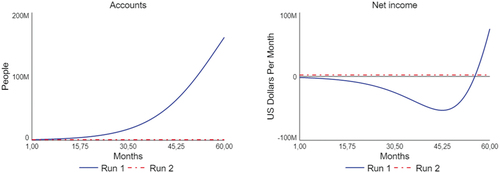
2) Accounts = 0 accounts; Run 1: Reference behavior (GH strategy in place); Run 2: Test
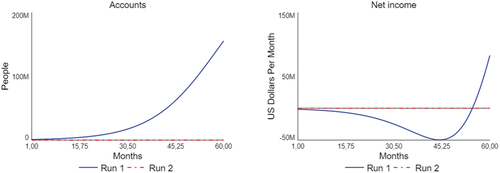
Sensitivity analysis
1) Avg. value of transaction = 5 dollar/transaction (instead of 20); Run 1: Reference behavior (GH strategy in place); Run 2: Test
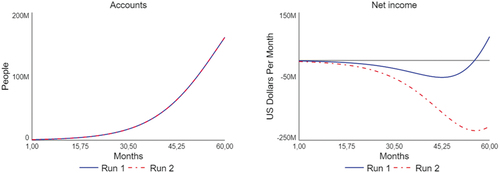
2) Fee for transaction = 0.01 (instead of 0.029); Run 1: Reference behavior (GH strategy in place); Run 2: Test
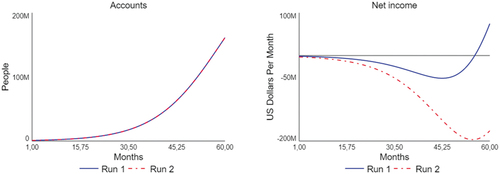
3) Transaction per accounts = 10 transaction/account/month (instead of 4); Run 1: Reference behaviour (GH strategy in place); Run 2: Test
